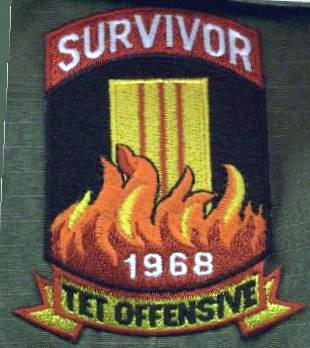|
|

1968 TET Offensive Survivor Patch

1968 TET Offensive Silver Anniversary Patch

Tet Offensive in Vietnam, 1968
3 February Military History Office Dr. Saunders
It was thirty years ago that the Tet Offensive (named General Offensive-General Uprising by the North Vietnamese) began in South Vietnam. Although intelligence estimates indicated an unprecedented amount of supplies were moving down the Ho Chi Minh Trail and three North Vietnamese Division Headquarters and seven regiments (about 15,000 men) had arrived near Khe Sanh, north of Hue, the U.S. leadership did not fully understand the gravity of the situation. Speeches by senior leaders indicated that a possible all-out offensive might develop, but it was unlikely.
Tet, or the lunar new year, the Vietnamese most festive holiday, resulted in a declared 36 hour truce and home leave for many of South Vietnam's military. Although some leaves were cancelled, ARVN strength was at about 50 per cent when the attacks were launched on five of the most important cities in South Vietnam, thirty-six provincial capitals, sixty-four district capitals, and fifty hamlets. In the city of Hue, eight battalions stormed the city isolating the U.S. Advisory team. In well-coordinated attacks in the capital of Saigon, three U.S. military barracks, the Presidential Palace, the city radio station, Ton Son Nhut Air Base, and the recently constructed U.S. Embassy were all attacked.
American soldiers, on alert for the possible attacks, reacted quickly and well and fought stubbornly in small units. The battle for the northern city of Hue went from house to house and lasted for a month. The North Vietnamese lost 45,000 men, over half of the strength they committed, and were unable to attack in strength for the next two years. The American public, watching graphic footage on the televised evening news, began to question the Johnson administration's handling of the conflict.
The Tet offensive brought the war to the cities for the first time and the resulting devastation created many refugees. GEN Westmoreland moved quickly to establish Operation Recovery to coordinate the rebuilding process. While the North Vietnamese failed in their attempt to start a mass uprising in the cities, they controlled the villages and the countryside, making the U.S.-led Pacification program more difficult.
The Tet offensive of 1968 demonstrated that despite the element of surprise, American soldiers were able to repel determined and well coordinated attacks. Small unit tactics, excellent NCO leadership, and determination of the soldiers were able to turn the tide for the Americans.
|
|
|
|
|
 Vietnam War History
Vietnam War History
